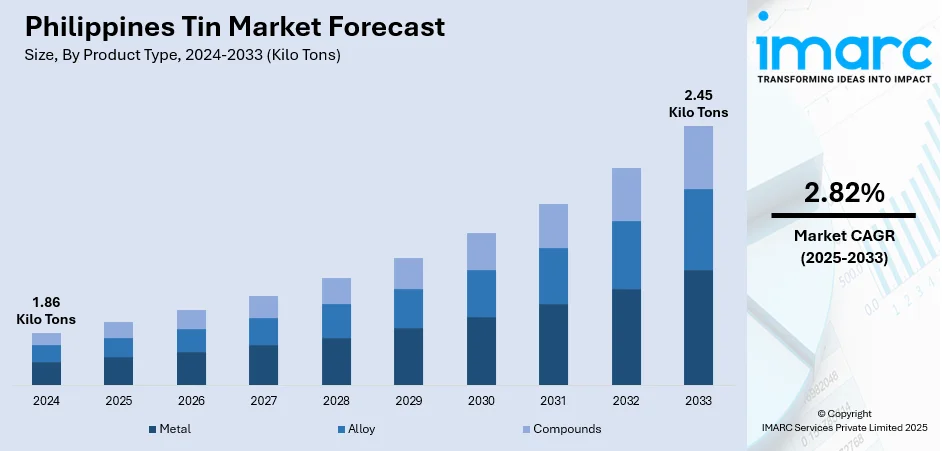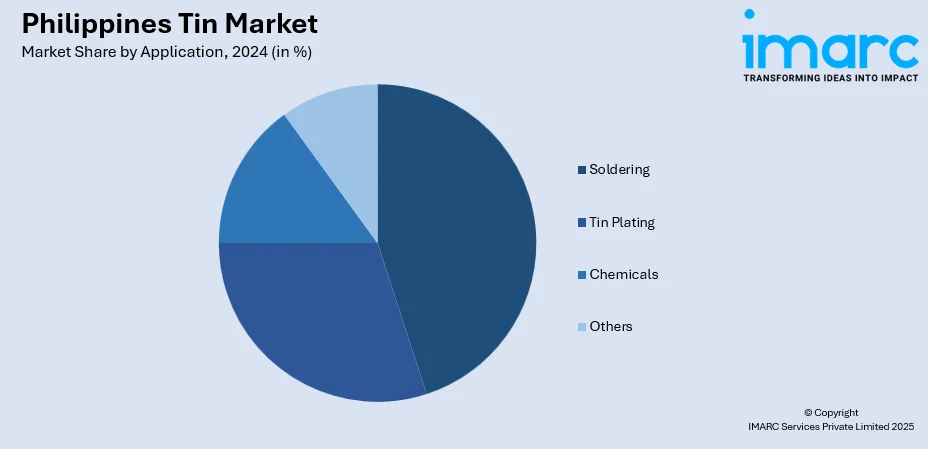
Philippines Tin Market Size, Share, Trends and Forecast by Product Type, Application, End-Use Industry, and Region, 2025-2033
Philippines Tin Market Overview:
The Philippines tin market size reached 1.86 Kilo Tonnes in 2024. Looking forward, the market is expected to reach 2.45 Kilo Tonnes by 2033, exhibiting a growth rate (CAGR) of 2.82% during 2025-2033. The market is witnessing steady growth, driven by the rising demand from the packaging, electronics, and automotive industries. Increasing applications in soldering, coatings, and alloys are also supporting market expansion. Moreover, industrial development and technological advancements are fostering opportunities, further strengthening the competitive landscape of the Philippines tin market share.
|
Report Attribute
|
Key Statistics
|
|---|---|
|
Base Year
|
2024 |
|
Forecast Years
|
2025-2033
|
|
Historical Years
|
2019-2024
|
| Market Size in 2024 | 1.86 Kilo Tonnes |
| Market Forecast in 2033 | 2.45 Kilo Tonnes |
| Market Growth Rate (2025-2033) | 2.82% |
Philippines Tin Market Trends:
Expanding Electronics and Soldering Applications
One of the strongest drivers of the market is its extensive use in the electronics sector, particularly in soldering applications. Tin is a key component in solder, which is essential for assembling circuit boards, semiconductors, and other electronic devices. The Philippines has a major share in the world manufacturing and exporting of electronics, and this is increasing the demand for tin. The rising demand for smartphones, computers, and domestic appliances at both local and global levels further promotes the use of tin in the manufacture of solder. Furthermore, the need to go lead-free with respect to solders in the industry because of environmental and regulatory pressures is augmenting the competitive advantage of high-quality tin-based solutions as vital inputs to product quality, durability, and adherence to timely compliance with standards established across the globe.

To get more information on this market, Request Sample
Rising Demand from the Packaging and Food Industry
The growing use of tin in packaging, particularly for canned food and beverages, significantly contributes to the Philippines tin market growth. Tin’s corrosion-resistant properties and ability to preserve freshness make it an ideal material for food-safe packaging, aligning with rising consumer demand for packaged and processed food products. Urbanization, changing lifestyles, and an expanding middle class are driving higher consumption of canned goods, beverages, and ready-to-eat meals. Additionally, export-oriented food processing companies are increasingly adopting tin-based packaging to meet international quality standards. As sustainability and recycling gain importance, tinplate packaging is also gaining preference due to its eco-friendly attributes. This sustained demand from the food and beverage sector ensures steady opportunities for the Philippines tin market, reinforcing its long-term importance.
Growth in Automotive and Industrial Applications
The Philippines tin market is also supported by increasing demand from the automotive and broader industrial sectors. Tin is widely used in alloys such as bronze and soldered joints, which are critical in automotive parts, machinery, and industrial equipment. The country’s expanding automotive market, driven by rising vehicle ownership and assembly operations, creates consistent requirements for tin-based materials. Beyond vehicles, tin is utilized in coatings, batteries, and specialized components that enhance durability and performance in industrial applications. As infrastructure development and industrialization accelerate, the demand for reliable metals like tin is growing across multiple sectors. This broader adoption highlights tin’s versatility and ensures its continued relevance in supporting both traditional manufacturing and modern industrial advancements in the Philippines.
Philippines Tin Market Segmentation:
IMARC Group provides an analysis of the key trends in each segment of the market, along with forecasts at the country and regional levels for 2025-2033. Our report has categorized the market based on product type, application, and end-use industry.
Product Type Insights:
- Metal
- Alloy
- Compounds
The report has provided a detailed breakup and analysis of the market based on the product type. This includes metal, alloy, and compounds.
Application Insights:

- Soldering
- Tin Plating
- Chemicals
- Others
The report has provided a detailed breakup and analysis of the market based on the application. This includes soldering, tin plating, chemicals, and others.
End-Use Industry Insights:
- Automotive
- Electronics
- Packaging (Food and Beverages)
- Glass
- Others
A detailed breakup and analysis of the market based on the end-use industry have also been provided in the report. This includes the automotive, electronics, packaging (food and beverages), glass, and others.
Regional Insights:
- Luzon
- Visayas
- Mindanao
The report has also provided a comprehensive analysis of all the major regional markets, which include Luzon, Visayas, and Mindanao.
Competitive Landscape:
The market research report has also provided a comprehensive analysis of the competitive landscape. Competitive analysis such as market structure, key player positioning, top winning strategies, competitive dashboard, and company evaluation quadrant has been covered in the report. Also, detailed profiles of all major companies have been provided.
Philippines Tin Market Report Coverage:
| Report Features | Details |
|---|---|
| Base Year of the Analysis | 2024 |
| Historical Period | 2019-2024 |
| Forecast Period | 2025-2033 |
| Units | Kilo Tonnes |
| Scope of the Report |
Exploration of Historical Trends and Market Outlook, Industry Catalysts and Challenges, Segment-Wise Historical and Predictive Market Assessment:
|
| Product Types Covered | Metal, Alloy, Compounds |
| Applications Covered | Soldering, Tin Plating, Chemicals, Others |
| End Use Industries Covered | Automotive, Electronics, Packaging (Food and Beverages), Glass, Others |
| Regions Covered | Luzon, Visayas, Mindanao |
| Customization Scope | 10% Free Customization |
| Post-Sale Analyst Support | 10-12 Weeks |
| Delivery Format | PDF and Excel through Email (We can also provide the editable version of the report in PPT/Word format on special request) |
Key Questions Answered in This Report:
- How has the Philippines tin market performed so far and how will it perform in the coming years?
- What is the breakup of the Philippines tin market on the basis of product type?
- What is the breakup of the Philippines tin market on the basis of application?
- What is the breakup of the Philippines tin market on the basis of end-use industry?
- What is the breakup of the Philippines tin market on the basis of region?
- What are the various stages in the value chain of the Philippines tin market?
- What are the key driving factors and challenges in the Philippines tin market?
- What is the structure of the Philippines tin market and who are the key players?
- What is the degree of competition in the Philippines tin market?
Key Benefits for Stakeholders:
- IMARC’s industry report offers a comprehensive quantitative analysis of various market segments, historical and current market trends, market forecasts, and dynamics of the Philippines tin market from 2019-2033.
- The research report provides the latest information on the market drivers, challenges, and opportunities in the Philippines tin market.
- Porter's five forces analysis assist stakeholders in assessing the impact of new entrants, competitive rivalry, supplier power, buyer power, and the threat of substitution. It helps stakeholders to analyze the level of competition within the Philippines tin industry and its attractiveness.
- Competitive landscape allows stakeholders to understand their competitive environment and provides an insight into the current positions of key players in the market.
Need more help?
- Speak to our experienced analysts for insights on the current market scenarios.
- Include additional segments and countries to customize the report as per your requirement.
- Gain an unparalleled competitive advantage in your domain by understanding how to utilize the report and positively impacting your operations and revenue.
- For further assistance, please connect with our analysts.
 Request Customization
Request Customization
 Speak to an Analyst
Speak to an Analyst
 Request Brochure
Request Brochure
 Inquire Before Buying
Inquire Before Buying




.webp)




.webp)












